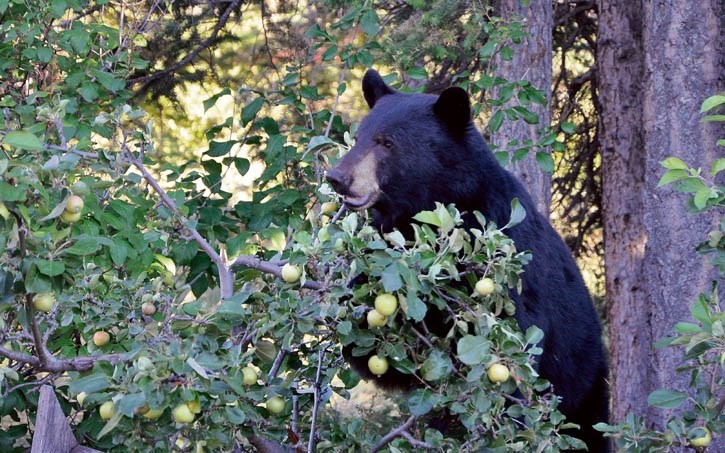BANFF – At least five black bears are hanging around the Banff townsite in search of an easy meal to fatten up ahead of the long winter’s hibernation.
Parks Canada started getting several calls last Thursday (Sept. 7), prompting wildlife experts to remind residents to pick fruit off trees or cut them down as part of Banff’s tree removal program, and keep garbage and other wildlife attractants properly stored.
“We had about five different bears in fairly close to town that we had calls on,” said Blair Fyten, Parks Canada’s human-wildlife coexistence specialist for Banff National Park.
“Theses bears are back and it’s prior to denning time so they’re looking for any food they can find.”
While not a bumper crop in the Bow Valley this year, the buffaloberry (shepherdia) crop was considered above average this season, attracting many bears to the Bow Valley.
“On Tunnel Mountain the shepherdia crop was very good and that attracted a lot of bears into the area,” said Fyten.
“We had bears in the campground that were eating on shepherdia that we had to haze off multiple times.”
With the buffaloberry crop dying off, bears are now in search of other calorie-rich food in preparation for winter’s hibernation, going into the den around October and November and not typically coming out until April or May.
They’re trying to eat as much as they can to sustain themselves throughout the long winter.
One collared black bear the wildlife team had to deal with on many occasions at Tunnel Mountain campground this summer took off to Kootenay National Park as soon as the berry crop here started to wither.
The bear, which was collared last year as part of the hot-wire fencing project to keep bears off the Trans-Canada Highway near Banff, stayed in the Floe Lake area for almost a month, likely taking advantage of the healthy huckleberry crop there.
“It was literally like two days – one day he was here and then two days later he was up towards Floe Lake where he stayed for almost a month,” said Fyten.
“He just recently has come back to the Bow Valley, but it was kind of neat seeing the movement that he did.”
Parks Canada and the Town of Banff are encouraging residents to take part in the municipality’s fruit tree removal incentive program, which covers 100 percent of costs in order to replace a fruit tree.
In August, new rules were passed by the Town giving the municipality the power to order removal of fruit trees when there is clear evidence wildlife have feasted on fruit and could pose a danger to the public – or the animal.
Since 2019, Banff’s municipal enforcement department has recorded 102 incidents in which wildlife got into garbage, food waste, recyclables, and fruit trees, including two files of deer eating pumpkins during Halloween.
Last fall, Parks Canada was forced to kill two habituated bears – a mother and her cub – after they fed on multiple crabapple trees throughout town, including the industrial compound, the downtown core and in Middle Springs.
Fyten said about 22 crabapple trees have been removed since 2015 and a revised list indicates there are at least 34 trees remaining throughout town.
“Pick the crabapples and get rid of them because past experience tells us that if we have a bear that gets into a crabapple tree that it’s very hard to haze out of town,” said Fyten.
“A lot of these bears we’ve had to euthanize in the past.”
Sightings of grizzly bears around town have been minimal this year.
Fyten said bear 122, the so-called patriarch of the Bow Valley known as The Boss, and bear 136 named Split Lip for his disfigured mouth, have spent much of their time further west in the Banff National Park.
But he said bear 122 was spotted near Banff about a week ago.
“He entered through very quickly,” he said.
“It’s been very quiet with grizzly bears this year. We catch a few on our trail cameras that we have fairly close by, but sightings have been very minimal.”



